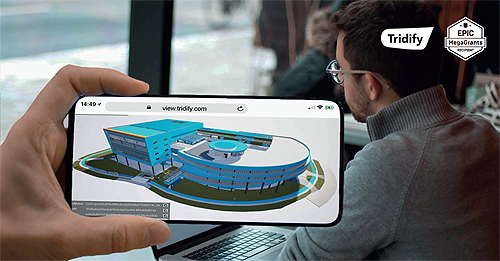
New ways of working
As the world remains in the grip of Covid-19, the monumental shift in how technology is supporting staff working from home is set to continue in 2021 and beyond. But how are developments in BIM improving the way people work and how will 5G and BIM streaming soon be transforming the efficiency of AEC workflows even further?
During 2020, those who had been delaying the digitalization of construction processes found themselves accelerating how technology could help introduce new ways to operate. Many organizations we talked to already recognized the  benefits of digital tools and how they could improve collaboration and streamline workflows. Then the onset of the Coronavirus pandemic simply forced many to change the way they did business.
benefits of digital tools and how they could improve collaboration and streamline workflows. Then the onset of the Coronavirus pandemic simply forced many to change the way they did business.
Improved virtual collaboration
Processes in the construction planning phase involving BIM, for example, were accelerated by using various online tools already available. They supported home working, as they do not rely on certain physical hardware requirements and processing power, normally only found on an office PC. By making BIM models more easily accessible online, less physical meetings are needed to discuss them and clients or colleagues are able to view then when they want – on mobiles or the desktop. By updating team members in this way, with more 3D models online, engagement increases and everyone has a better understanding of a space.
New ways of sharing BIM models like this also extends the lifecycle of BIM outside its traditional realm. By eliminating barriers to sharing 3D models, they become a valuable asset, not a liability. Users now view BIM as a long-term benefit and can easily take advantage of models for the entire lifecycle of a building, not just for the planning and construction phase, but also in facilities management, training and maintenance, for example.
Widen your stakeholder audience
These developments are helping to drive the use of BIM amongst new stakeholders too, so not just the core BIM cohort but non-technical groups – anyone who could benefit from seeing a 3D model, including contractors and personnel on site, marketing, sales, IT, finance, contracts, etc. Plus, externally, with stakeholders such as planners and government bodies.
By making BIM models easily viewable online, new faster workflows are created which challenges the status quo. A workflow that reduces the time it takes architects to communicate internally or externally, with staff, clients, contractors or anyone else who benefits from seeing an interactive model. This helps solve the problem of misunderstandings in the design process and underpins better collaboration during construction between architects, contractors or clients.
Future developments
A major new development on the horizon is the roll-out of 5G, which will be the catalyst for the next generation of construction software. Like 3G and 4G before it, the huge jump in bandwidth which 5G delivers will make the largest BIM models, VR and other data-intensive applications run far more smoothly and faster than ever. Being able to view any size or type of BIM model, on any device, will be a major milestone in the streamlining of AEC workflows and it’s not far off.
Over the last few years, the construction industry has struggled with how to share complete models of large scale developments such as airports, hospitals or shopping malls with everyone, anywhere, without any technical or financial barriers. Due to the size of data involved and restrictions of mobile devices, such as their memory, viewing large models remotely has made collaboration difficult.
In the same way that increased bandwidth in the home enables faster downloads of Netflix or effortless streaming, so 4G is now enabling BIM streaming. But 5G will accelerate the adoption of streaming of any size model from the cloud, direct to any device. This will introduce vastly improved collaboration methods for AEC professionals and transform the working practices of architects, engineers and BIM managers, as they seamlessly interact with complex BIMs from any location.
Covid-19 has accelerated some significant AEC technology developments – you definitely don’t need to go into an office to view a 3D BIM model any more. And with the increasing number of AEC design and VR applications being available in the cloud, along with the emergence of 5G, BIM streaming will soon introduce yet more revolutionary ways to communicate.
Alexander Le Bell is the CEO of Tridify. Tridify has been developing VR solutions for over 30 years, focused on automating the delivery of 3D models to improve AEC workflows and introduce new ways of collaborating. Customers around the world include WSP, Skanska, DPA Architects and City of Helsinki. The company was also recently awarded an Epic MegaGrant to develop a BIM streaming tool for Unreal Engine.
www.tridify.com